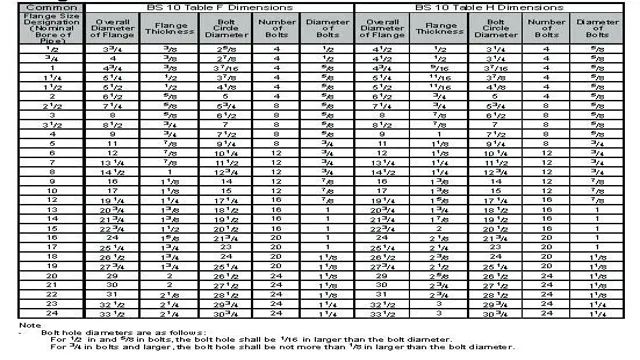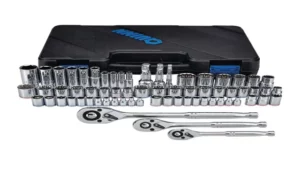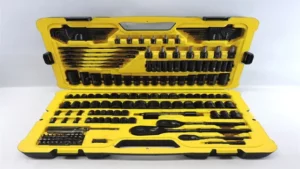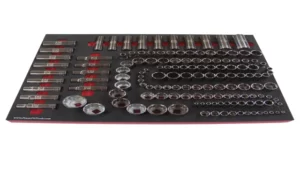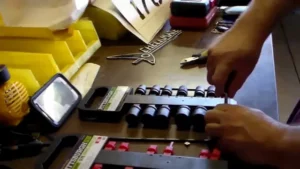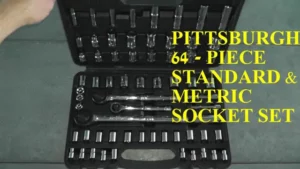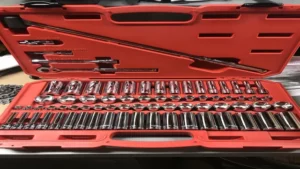Picture this: you’re midway through a DIY project and you realize you need a socket wrench. But as you reach for your trusty tool kit, you find yourself wondering which standard socket set size you need. Don’t worry; we’ve all been there.
Choosing the right socket set size can be a bit of a nightmare, especially when you’re faced with a variety of sockets and bolts. In this guide, we’ll break down everything you need to know about standard socket set sizes, how they work, and which sizes are the most commonly used. By the end, you’ll be a socket set pro and won’t have to worry about your projects grinding to a halt due to a lack of proper tools.
So let’s dive in, shall we?
What is a Socket Set?
When it comes to a socket set, you might be wondering what sizes are typically included in a standard set. The answer can vary, but most socket sets will come with a range of sizes, usually in both metric and imperial measurements. A standard socket set may include sizes from 4mm to 19mm for metric sockets and 3/16 inch to 1 inch for imperial sockets, with a few additional sizes thrown in depending on the specific set.
It’s important to note that some sets may have more specialized or narrow ranges, depending on their intended use, so it’s always worth double-checking before you purchase. Regardless of the specific sizes, having a good socket set on hand can make all the difference when it comes to tackling tough DIY projects or taking care of routine maintenance on your vehicles or home.
Socket Set Components
A socket set is a collection of tools that are designed to tighten or loosen bolts and nuts. It is composed of various components such as sockets, ratchets, extensions, and adapters. The sockets are the cylindrical attachments that fit over the head of a nut or bolt.
Ratchets are the tools that allow sockets to be turned clockwise or counterclockwise to tighten or loosen the nuts and bolts. The extensions are used to give extra length to the ratchet handle, and the adapters are used to switch the size or drive of the sockets. A socket set is a versatile and essential tool for any DIY enthusiast or mechanic.
It comes in different sizes and configurations to suit different needs and applications. Whether you are repairing your car, fixing home appliances, or building something from scratch, a socket set is your go-to tool for fastening and loosening nuts and bolts. So, make sure you have a quality socket set in your toolkit, and you will be ready to tackle any project that comes your way.
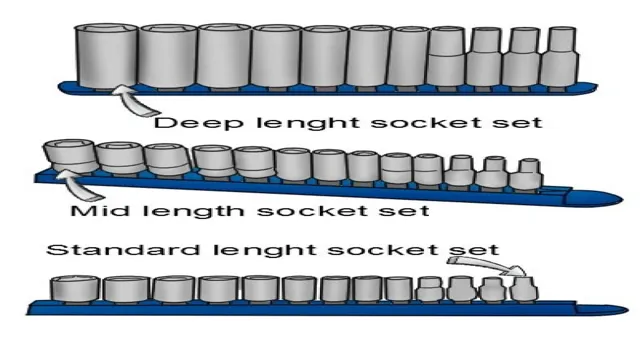
Metric and SAE Units
A socket set is a collection of different socket wrenches which come in various sizes, shapes, and types. The purpose of a socket set is to tighten or loosen bolts and nuts, making it an essential tool for mechanics and DIY enthusiasts. Metric and SAE units are the two key measurement systems used in socket sets.
Metric is predominantly used in Europe and other international regions, while SAE is primarily used in America. It’s essential to choose the correct system for the job to ensure the right size socket is being used. When shopping for a socket set, it’s always a good idea to check whether the set contains both metric and SAE units.
This way, you can be sure that you have the correct socket size for the job at hand. Metric units are usually measured in millimeters, while SAE units are measured in inches. Both units come in a variety of sizes to fit different nut and bolt sizes, so it’s important to refer to the size chart to ensure the correct size is being used.
In summary, a socket set is an indispensable tool for anyone who works with nuts and bolts, and choosing the correct metric or SAE unit is crucial in ensuring that the job gets done right.
Standard Socket Set Sizes
If you’re in the market for a new socket set or are just curious about what sizes are in a standard socket set, you’re in the right place. The most common socket set sizes are 1/4 inch, 3/8 inch, and 1/2 inch. Within those sizes, you can expect to find sockets ranging from 4mm up to 24mm and beyond.
Some sets may also include larger sockets for specialty jobs, such as removing lug nuts on larger vehicles. It’s important to note that not all socket sets are created equal, so it’s worth checking the specific contents of the set before making a purchase. And if you ever need a socket size that isn’t in your set, you can always purchase individual sockets to add to your collection.
Metric Sizes
Metric Sizes Standard socket sets come in both metric and imperial sizes, with the metric being the most commonly used size measurement in recent times. Metric sizes are measured using millimeters, and they are becoming the go-to measurement system preferred by modern mechanics and technicians alike. This is because they offer more precise measurements, which leads to better accuracy when it comes to completing repairs and maintenance.
If you’re looking to purchase a standard socket set that is compatible with metric sizes, then make sure to choose one that comes in a range of sizes, from 6mm to 24mm, to cover all your repair needs. With metric sizes being widely used, it’s essential to have a socket set that can handle all your repair requirements, making your job much more comfortable and efficient. So, the next time you’re looking to purchase a standard socket set, ensure you opt for a set that includes metric sizes.
SAE Sizes
SAE Sizes If you are new to the world of socket sets, it can be overwhelming to see the variety of sizes available. Standard Socket Set Sizes usually are indicated in SAE (Society of Automotive Engineers) Units, which represent a system of measuring that includes inches, fractions and decimals. The most common sizes found in tool sets vary from 1/4-inch drive sockets, 3/8-inch drive sockets, and 1/2-inch drive sockets, then they usually range from 3/16 inches to 1-1/2 inches.
However, larger sets might include sizes up to 2 inches or even more. Even miniature sizes such as 1/8-inch and 5/32-inch SAE sockets are also essential to complete your tool collection. It’s recommended to own a comprehensive set of socket sizes to tackle any project that comes along, so that your job gets completed with ease.
Socket Set Size Charts
Socket Set Size Charts Selecting the right socket set size is essential to ensure that you have the right tool to get the job done correctly. Socket sets usually come in standard sizes that are measured in inches and are either fractional or metric. The most common sizes for fractional sockets are 1/4″, 3/8″, 1/2″, 3/4″, and 1″.
On the other hand, metric sockets come in sizes that range from 4mm to 32mm, usually found in 1/4″, 3/8″ and 1/2″ drives. The drive size refers to the square connector on the socket that fits the ratchet or wrench handle. Moreover, large socket sizes are usually more expensive, but they are more durable and often used for professional applications.
Conversely, smaller sized sockets are commonly used for DIY projects around the home or on smaller projects, and they can typically be found in any size set. It’s important to remember that different brands may have different socket set size selections, so it’s always best to check the chart size before making any purchases.
Choosing the Right Socket Set Size
When it comes to choosing the right socket set size, there are a few things to keep in mind. Generally, standard socket sets will include sizes ranging from 1/4 inch to 1/2 inch. The most common sizes are 3/8 inch and 1/2 inch, which are used for larger nuts and bolts.
However, it’s important to also have smaller sizes on hand for precision work, such as a 1/4 inch socket for smaller nuts and bolts. It’s always best to have a variety of sizes available in your socket set, so you can tackle any job that comes your way. Don’t forget to also consider the drive size of your sockets, which will generally be either 1/4 inch, 3/8 inch, or 1/2 inch.
Choosing the right socket set size can make all the difference when it comes to completing your projects efficiently and effectively.
Factors to Consider
Choosing the right socket set size can be a daunting task, especially if you are new to the world of DIY. There are several factors to consider before making your selection, including the quality of the socket set, the type of projects you will be working on, and the size of the bolts you will be handling. Quality is an important factor since a well-made socket set is essential for long-term use and durability.
It is also essential to choose a set that suits the size and type of the projects you are taking on. Be sure to consider the thickness and length of the socket, as well as the size of the bolts you’ll be dealing with. You don’t want the socket to be too big or too small for your needs.
Ultimately, choosing the right socket set size is a matter of assessing your specific needs and selecting the right tool for the job.
Common Socket Set Sizes for Different Applications
When it comes to choosing the right socket set size, it’s important to consider what type of work you’ll be doing. If you’re working on small engine repairs or electronics, a smaller socket set with sizes ranging from 4mm-13mm may be sufficient. For larger automotive repairs or construction, a larger set with sizes ranging from 10mm-24mm will be more useful.
Additionally, it’s a good idea to invest in a universal joint socket for those hard-to-reach areas and an extension bar to add length when necessary. Keep in mind that it’s always better to have a socket that’s too big than too small, as you can use shims or adapters to make up the difference. By choosing the right socket set size for your specific needs, you’ll be able to tackle any project with ease and efficiency.
Conclusion
In conclusion, determining what sizes are in a standard socket set can be a bit of a puzzle. It’s like trying to solve a Rubik’s Cube, except instead of colors, you’re dealing with metric and imperial measurements. Nevertheless, with a little bit of patience and the right tools (aka a socket set), you can tackle any nuts or bolts that come your way.
Just remember, there’s no shame in asking for help from a more experienced mechanic, or in admitting that you need a bigger socket – sometimes, size does matter!”
FAQs
What is a socket set?
A socket set is a collection of tools used for tightening or loosening bolts and nuts.
How many different socket sizes are in a standard socket set?
A standard socket set typically includes sizes ranging from 4mm to 19mm for metric sets and 3/16″ to 7/8″ for SAE (Imperial) sets.
Can socket sets be used for different types of fasteners?
Yes, socket sets can be used for different types of fasteners, but they should match the shape of the bolt or nut head.
How do you choose the right socket size for a bolt or nut?
To choose the right socket size, measure the width of the bolt head or nut across the flats, and match it to the corresponding socket size.
Can sockets be used with power tools?
Yes, sockets can be used with power tools such as impact wrenches and drills, but make sure to use the correct size and type of socket adapter.
What are the different types of socket sets available in the market?
There are various types of socket sets available such as standard, deep, shallow, impact, universal joint, and spark plug sockets.
Can sockets wear out over time and use?
Yes, sockets can wear out over time and use, especially if they are used extensively on hard materials or at high torque settings. It is important to replace them regularly to ensure proper functionality.
